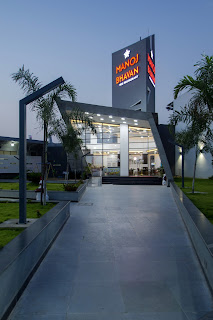REVISIT MEMORIES
#2- DR.ARUNACHALAM HOUSE
NUNGAMBAKKAM
“An architect is– necessarily- a great poet.
He must be a great original interpreter of his time, his day and his age.”
-Frank Lloyd Wright
We continued along
the Revisit Trail, towards Nungambakkam, a busy part of Chennai, to chronicle
the home of Dr. Arunachalam & Dr. Vinutha Arunachalam.
The client,
belonging to Chettinadu, wanted to combine the
traditional cultural living to contemporary spaces, and thus was born the
concept that drove the design of this eloquent, sprawling home.
The client also
wanted to recycle and incorporate elements from his ancestral property and that of his relatives, to create his home in
the heart of Chennai. The 1½ ground property was thoughtfully zoned to create
comfort and privacy for its residents.
At the entry, a set
of steps led to the basement, with parking space for 2 cars, and 2 rooms that form
a clinic that accommodates our doctor couple’s medical practice.
Moving on, we
arrived at the ground floor of the home with its large central courtyard and swimming
pool for their adorable toddler. The spacious formal living room was furnished
with teakwood and we were pleasantly surprised as the marble floor was suddenly
replaced by glass, revealing the Koi fish pond beneath.
The central courtyard linked all the levels
of their home, with a large double height void that made the house permeable to
light and fresh air. We stood, awestruck at the scale of the space, with its
rustic stone cladding from Mahabalipuram and a majestic Buddha mural, also in
stone. The courtyard was fitted with a retractable
roof that prevented the rainwater from entering the home, while also
creating soft shading within.
The stained glass
windows and grandfather clocks that chimed at different intervals, gave an
ethereal quality to the experience of the space.
Traditional
windows, doors and wooden ceiling that earlier belonged to Dr. Arunachalam’s
ancestral property were integrated into contemporary design.
The play of levels was evident as we
climbed up the stairs, the midlanding of which led to their son’s bedroom and a
home theatre, with dramatic lighting and dusky wooden walls that transported us
to the culture of Chettinad.
The bedrooms were on
the first floor, with large glass windows that had views out to the vertical garden screen walls, which
made us feel like we were amidst nature.
Our last stop was
at the terrace, with its lush growth
of greenery, where one could recline on the
thinnai facing the garden. The clients usually invite their friends over on
the weekends, to enjoy a quiet evening, relaxing after the busy schedules,
amidst the lush greenery that made the home stand out like an OASIS within the city.
































































